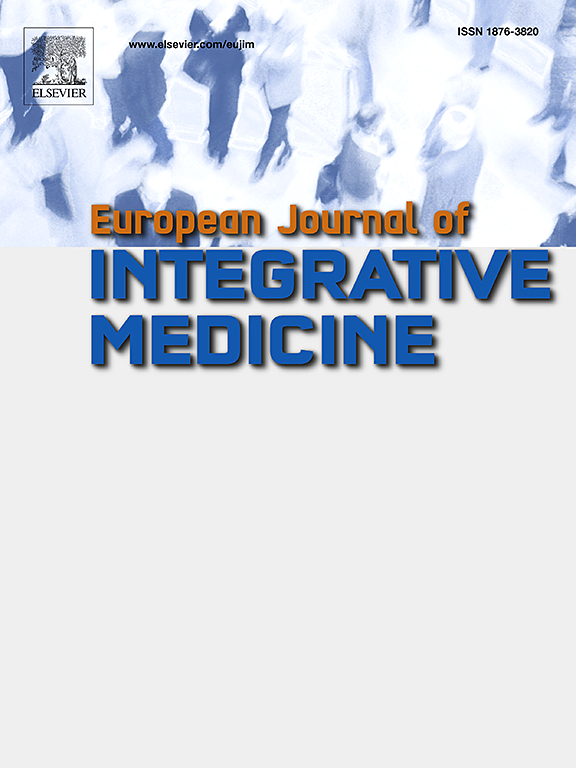Herbal medicine treatment patterns for Parkinson’s disease: A nationwide population-based medical claims database in South Korea
IF 1.7
4区 医学
Q3 INTEGRATIVE & COMPLEMENTARY MEDICINE
引用次数: 0
Abstract
Introduction
Parkinson’s disease (PD) is characterized by heterogeneous symptoms and long disease progression and requires individualized treatment. This study aimed to elucidate large-scale herbal medicine patterns according to age, duration of disease progression, and various detailed symptoms of PD, as well as examine comorbidities to build a basis for clinical applications.
Methods
We analyzed data from the Korean National Health Insurance System cohort database regarding patients with PD who received herbal medicines between 2014 and 2020. We identified 10,060 patients with various prescription patterns based on age and PD duration. Additionally, to estimate the potential therapeutic mechanisms of insured herbal medicines for the clinical symptoms of PD, we conducted a literature review of the results of clinical and preclinical studies.
Results
The overall insurance-covered herbal medicine prescriptions for patients with PD had increased in both the number of prescriptions and patients over time. The herbal medicine use rate in patients with PD was the highest between ages 70 and 79 years and within 3 years of PD onset. Doinseunggi-tang, Haengso-tang, and Palmul-tang were the most frequently used herbal medicines. The most common comorbidities diagnosed along with PD were musculoskeletal and digestive diseases.
Conclusion
Some insurance-covered herbal medicines are frequently used among patient groups in a specific age group or duration of disease, and our literature review indicates a correlation between the mechanism of action of these herbal medicines and a specific subgroup of patients with PD. To validate these results and draw meaningful conclusions that reflect the realities of Korean medicine clinical practice, including non-reimbursed treatments, further prospective large-scale clinical trials considering age and disease progression duration are required.
Funding
This work was supported by a National Research Foundation of Korea grant.
帕金森病的草药治疗模式:韩国基于全国人口的医疗索赔数据库
帕金森病(PD)的特点是症状异质性和病程进展长,需要个体化治疗。本研究旨在根据PD的年龄、病程和各种详细症状,阐明大规模的草药用药模式,并检查合并症,为临床应用奠定基础。方法:我们分析了韩国国民健康保险系统队列数据库中2014年至2020年期间接受草药治疗的PD患者的数据。我们根据年龄和PD病程确定了10060例不同处方模式的患者。此外,为了评估参保草药对PD临床症状的潜在治疗机制,我们对临床和临床前研究结果进行了文献综述。结果随着时间的推移,PD患者参保中草药处方数量和参保人数均呈增加趋势。PD患者中草药使用率在70 ~ 79岁及发病3年内最高。使用频率最高的是道成汤、杏素汤、八木汤。PD最常见的合并症是肌肉骨骼和消化系统疾病。结论某些参保草药在特定年龄组或病程的患者群体中经常使用,我们的文献综述表明这些草药的作用机制与特定亚组PD患者之间存在相关性。为了验证这些结果并得出有意义的结论,以反映韩国医学临床实践的现实,包括无报销治疗,需要进一步考虑年龄和疾病进展时间的前瞻性大规模临床试验。这项工作得到了韩国国家研究基金会的资助。
本文章由计算机程序翻译,如有差异,请以英文原文为准。
求助全文
约1分钟内获得全文
求助全文
来源期刊

European Journal of Integrative Medicine
INTEGRATIVE & COMPLEMENTARY MEDICINE-
CiteScore
4.70
自引率
4.00%
发文量
102
审稿时长
33 days
期刊介绍:
The European Journal of Integrative Medicine (EuJIM) considers manuscripts from a wide range of complementary and integrative health care disciplines, with a particular focus on whole systems approaches, public health, self management and traditional medical systems. The journal strives to connect conventional medicine and evidence based complementary medicine. We encourage submissions reporting research with relevance for integrative clinical practice and interprofessional education.
EuJIM aims to be of interest to both conventional and integrative audiences, including healthcare practitioners, researchers, health care organisations, educationalists, and all those who seek objective and critical information on integrative medicine. To achieve this aim EuJIM provides an innovative international and interdisciplinary platform linking researchers and clinicians.
The journal focuses primarily on original research articles including systematic reviews, randomized controlled trials, other clinical studies, qualitative, observational and epidemiological studies. In addition we welcome short reviews, opinion articles and contributions relating to health services and policy, health economics and psychology.
 求助内容:
求助内容: 应助结果提醒方式:
应助结果提醒方式:


